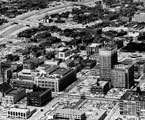
The Automobile Shapes The City
The “Footprint” of the Automobile on the American City
Modern American cities bear a powerful physical imprint of automobiles and other motorized vehicles. It is estimated that as much as one half of a modern American city’s land area is dedicated to streets and roads, parking lots, service stations, driveways, signals and traffic signs, automobile-oriented businesses, car dealerships, and more. Equally significant, space allocated for other forms of transportation ultimately shrank or disappeared. For example, sidewalks—normally considered essential to separate pedestrians from various transportation modes—were less often constructed along many urban roads and streets in the automobile era. Walking seemed increasingly incidental in moving people from place to place. Bicycle lanes, quite common in several European cities, were late-comers or non-existent in American cities as competitive forms of transportation were squeezed out by an increasing dependence on cars.
Nothing better illustrated the growing dominance of motorized vehicles than its imprint on the land-use patterns of cities. A parking study conducted in California stated that about 59 percent of the ground area in Los Angeles’ central business district (CBD) in 1960 was devoted to streets and parking, with about 35 percent for roads, streets, alleys, and sidewalks, and 24 percent for parking lots and garages not included in buildings with other purposes. During roughly the same period, acreage devoted to streets and parking in other urban cores was similar in scale or slightly less. In Detroit (1953), streets and parking made up 49.5 percent of the central city; in Chicago (1956), 40.7 percent; in Minneapolis (1958), 48.3 percent; Nashville (1959), 39 percent; and in Dallas (1961), 41.4 percent.
Ironically, motor traffic in the central cities tended to require less street space than was necessary for other forms of transportation before the rise of the automobile. Urban freeways, for example, require less than 3 percent of the land in the areas they serve. On the other hand, as automobiles and trucks ventured into areas not served by public transit, the need for more streets necessitated more construction. Also street and parking data do not include businesses or services devoted wholly or in part to the automobile, and do not give the broadest picture of how automobiles have remade the urban landscape well beyond their eighteenth- and nineteenth-century counterparts.
In the long run, core cities were clearly affected by the automobile, its major physical changes, and the flight of the middle class to the suburbs. Accommodating to the automobile most often required adapting cores to the needs of the car, be it changing the road system or adding gas stations, repair shops, auto parts stores, car washes, and automobile dealerships. However, adaptation did not mean remaking. In most cases, an automobile infrastructure was superimposed over cities that had undergone a variety of changes through time. Nevertheless, building new roads and highways within cities or adding automobile-related services did its share of changing—and in some cases destroying—human and animal habitats. Neighborhoods were cleaved, disrupted, or even eliminated. Plants and wildlife were threatened or dislocated.
<<Previous Section - Next Section>>
Introduction
The “Footprint” of the Automobile on the American City
From “Walking Cities” to “Automobile Cities"
Filling Stations and Other Services
Expressways, Freeways, and Superhighways
Complete Text Printable View
About the Project | Credits | Contact Us | Student & Teacher Resources | Site Map
©2004-2010 Automobile in American Life and Society
